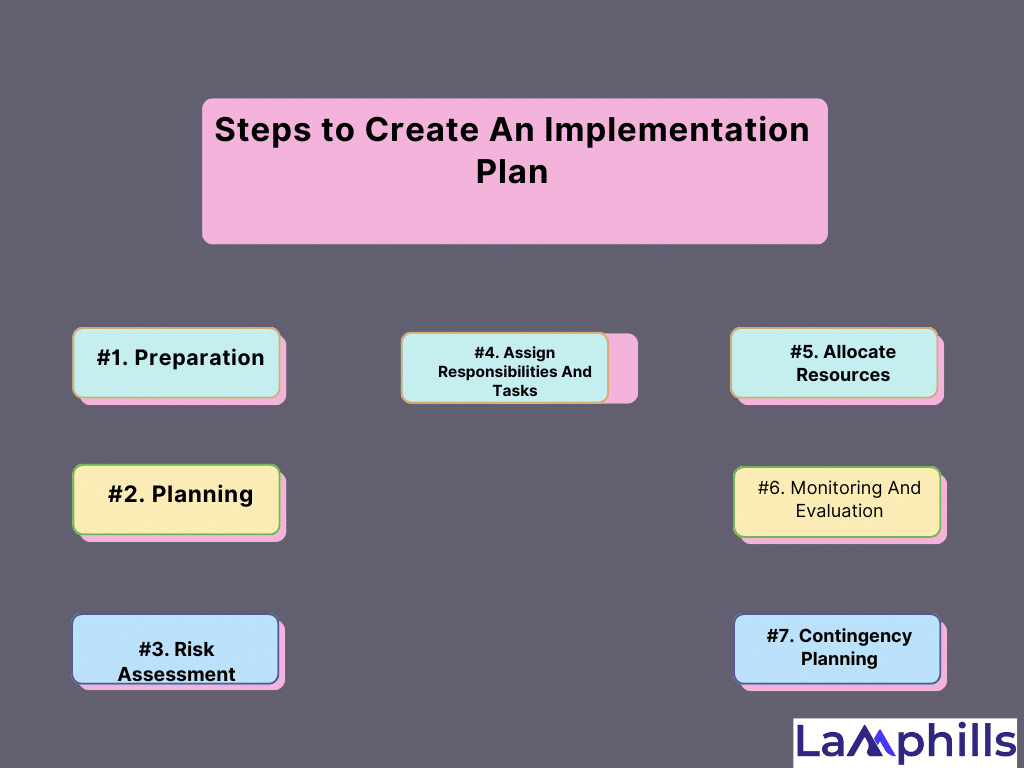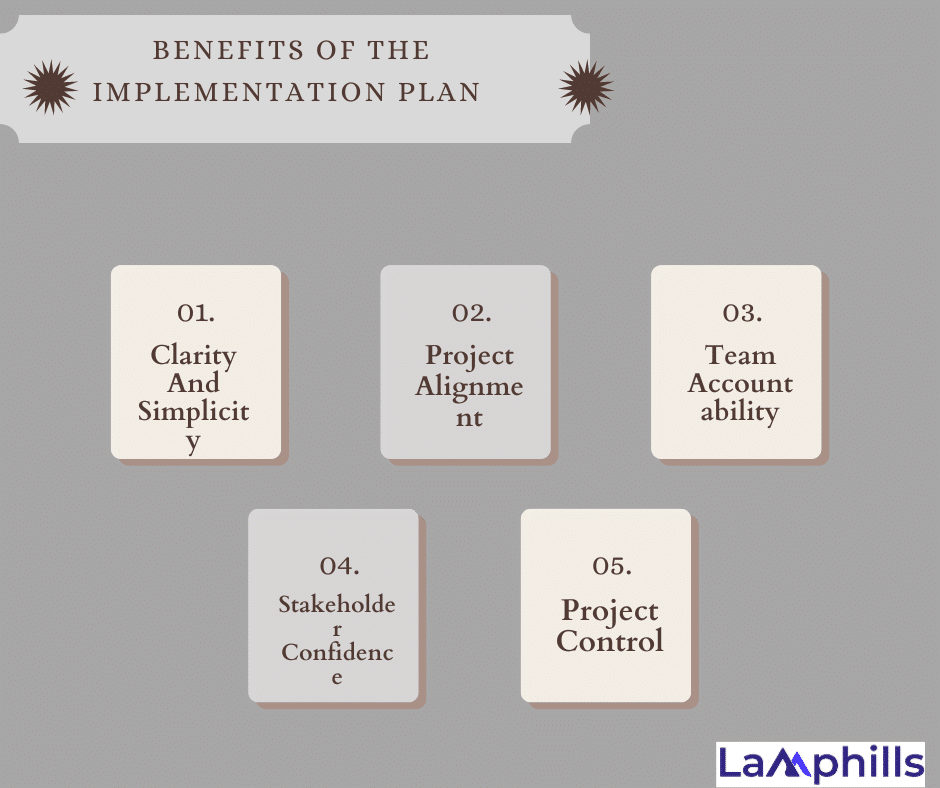Projects are similar to building a house—you wouldn’t start without a strong blueprint, right? Years ago, when I was transitioning from corporate strategy to startup advising, I had to learn this the hard way. One of my clients, a burgeoning e-commerce firm, had fantastic ideas but no implementation strategy. They had a product launch strategy, but nothing to help them figure out the “how.” Without a specific action plan, deadlines were missed, funds were mismanaged, and stress levels rose dramatically. That event served as my most important wake-up call: having an implementation plan is not only beneficial but also necessary. In this article, I’ll walk you through the crucial elements for creating an effective implementation plan that not only keeps your projects on schedule but also positions your company for success.
Key Takeaways
- An implementation plan acts as a detailed roadmap that ensures projects stay on track, deadlines are met, and stress is minimized. Without it, even the best strategies can fall apart due to poor execution and missed steps.
- A well-crafted implementation plan brings clarity to chaotic projects, turning confusion into confidence. It provides teams with clear steps, roles, and timelines, fostering a sense of direction and purpose.
- Essential elements like scope statements, resource plans, and timelines, coupled with risk assessments and contingency strategies, are the backbone of an effective implementation plan that ensures smooth execution.
- When roles and tasks are clearly defined, teams work more efficiently, and accountability is increased. This alignment leads to better collaboration and ensures that all team members contribute to the shared objectives.
What Exactly Is an Implementation Plan and Why Does It Matter?

Take an implementation plan to be a road map for action. You know where you want to go, but without precise directions, you’ll get lost or waste too much time roaming. It outlines the steps, deadlines, resources, and checkpoints necessary to achieve your strategic objectives.
I once worked for a medium-sized SaaS startup that was launching a new platform. They had developed a go-to-market strategy that included marketing methods and customer outreach. However, when I questioned, “How are we implementing this?” there was an awkward quiet. That is when I discovered the implementation plan was absent. Without one, even the most fascinating project might fail under its weight. The team had to rethink key aspects of the project multiple times, delaying the debut by six months. In simple terms, an implementation plan is the backbone of project success. It helps clarify responsibilities, mitigate risks, and ensure that everyone is on the same page.
Key Components of a Successful Implementation Plan
Most well-designed implementation plans have these basic components, but it’s vital to remember that implementation plans, like the projects they’re associated with, vary greatly. These pieces form a solid foundation for your next implementation plan. Start with these, but feel free to add any other elements that make sense for your industry or project type.
#1. Scope Statement
The scope statement describes the project’s scope — in other words, what work will be done (and what work is regarded out of scope).
#2: Project Milestones, Targets, And Main Objectives
One of the first things I learned while assisting organizations in implementing new strategies was the significance of establishing clear, measurable goals. Without a definite end objective, how can you tell if you’re succeeding?
Project goals are the high-level outcomes the project aims to achieve. Key objectives are the steps or intermediate outcomes that will occur throughout the project in support of the project goals. Project milestones are the points of measurement along the way, usually significant or tangible in some way. Examples of milestones across a few industry contexts include wireframe completed, beta launch, copy drafted, or the completion of a phase, segment, or function that’s part of the whole.
#3. Detailed Resource Plan
People are not the only resources; there are also tools, software, and time. One of my first consulting tasks was to create a CRM system for a retail chain. Halfway through, we ran out of software licenses due to a miscalculation of the number of users. That project taught me to constantly overestimate resources rather than rushing to find them afterward.
This is because a project’s resource plan identifies the human resources engaged, as well as their time or workload commitments. You should also mention the resources and equipment (usually only those that go beyond what every employee already has) required for the project’s successful completion.
#4. Estimated Implementation Timeline
I’ve discovered that timelines are not strict. They’re more like flexible frameworks. One of my favorite tools for this is a Gantt chart, which allows you to graphically plan out each stage of the process and see how one activity affects the next. However, remember to include buffer intervals for unanticipated delays. On a prior project, I discovered the value of time padding the hard way when we were confronted with a two-week delay due to unforeseen vendor issues.
#5 Implementation Plan Milestones
Your implementation plan may benefit from its own set of internal milestones, distinct from the larger project goals. These internal milestones are very effective for highly complex projects with many levels of approval and multiple departments providing information. Implementation plan milestones could look like these: initial stakeholder information gathered, plan drafted, plan discussed and feedback incorporated, and final sign-off by all stakeholders.
#6. Implementation Plan KPIs & Metrics
In complex projects, I often include internal milestones specifically for the implementation plan. These milestones keep the team focused. Your key performance indicators (KPIs) or other metrics reveal how well the team is accomplishing the implementation plan. Establish measurable indicators, state what they are within the plan itself, and then track them throughout the project.
An Implementation Plan Example
To further illustrate how to fill out this plan type, here’s an implementation example for a team that’s making website updates.
Project goal: Updating the website.
Project objectives: Update website to incorporate responsive design, include the latest user experience best practices, and refresh the look.
Success criteria: New website delivered in 12 weeks. Increase average time spent on site by 20% and revenue by 30%. Decrease bounce rate by 10%.
Scope statement: The website update project will require wireframes to outline updated navigation architecture and layout. The graphic design team will generate new visual assets to reflect current branding. The team will reuse existing website copy and functionality in this project.
Resource plan:
- An internal team of graphic designers, UX specialists, and web developers
- Space on the preview server for testing
- Stock imagery for updated graphics
- Volunteers to conduct end-user testing and generate feedback
Risk analysis: Graphic designers and website developers will be reassigned to higher-priority projects. Existing website functionality will break when integrated with the new, responsive framework. The production server will not be able to keep up with post-launch demand.
Project schedule:
Day 1: Kick-off meeting.
Day 3: Website layout and wireframe development begins.
Day 14: First review of wireframes and feedback delivered to designers.
Day 18–20: Staff holidays.
Day 28: Final review and edit of website wireframes.
Day 30: (milestone) Wireframes delivered to developers. Visual asset creation begins.
Day 40: 50% of website pages created and populated.
Day 50: (milestone) Developers complete website population.
Day 51: Content review. First round of edits was delivered.
Day 62: (milestone) Website uploaded to preview server. The user testing phase begins.
Day 70: Edits based on user testing delivered to developers.
Day 85: Final user acceptance testing.
Day 88: (milestone) Final approval for launch.
Day 90: (milestone) Website goes live at noon; team party at 3 p.m.
Steps to Create An Implementation Plan

Now you know what needs to go into your project implementation plan, but how do you create one and start the implementation process? I know this process can initially seem daunting, but it does take some upfront work. But the process doesn’t have to be as complicated as it seems. Follow these easy steps to create an implementation plan that helps keep your project and your team on track. Then, as future projects arise, use these questions as a template of sorts to create
#1. Preparation
Gather the project team and key stakeholders to go over the strategic strategy, then outline the project scope, objectives, and success criteria for each project. The implementation plan may only cover a piece of your overall strategic plan, therefore, it’s critical to outline how you’ll measure success for the extent of the work you intend to undertake.
This is comparable to goal setting in that you identify the project’s goals, such as time-based, performance-based, or outcome-oriented. Many firms believe that the goal-setting philosophy motivates teams and improves the process. Once you’ve established goals, objectives, and milestones and received buy-in from key stakeholders and project team members, you’re ready to go on to step two.
#2. Planning
During the planning stage, divide the project work into manageable tasks and activities. Define each task as carefully as possible so that you can readily track progress and discover bottlenecks early on.
These jobs are then organized according to dependencies and available resources. Define the duration of each activity and divide it into milestones with clear, quantifiable outcomes, such as finishing third-party integration or delivering a product for user approval testing.
When allocating resources, it is critical to specify the roles and responsibilities. For example, a developer may be held accountable for the overall completion of one assignment while still serving as a resource on another. When people understand their roles, they can work together to attain the goal.
#3. Risk Assessment
No matter how carefully you plan, something will go wrong. I’ve seen it too many times. A significant risk assessment on a manufacturing project I oversaw revealed that our key supplier might not achieve delivery schedules. When the supplier was delayed, we had a backup plan in place, saving us from a three-week disruption. Always ask yourself: What could go wrong, and how will we react? So, identify any potential hazards you may face. Determine each risk’s probability and impact as part of the risk assessment process. The following procedure can be useful.
- Determine the probability of the risk occurring using a high, medium, and low number scale.
- Assess the potential impact on the project using the same number scale for high, medium, and low.
- Calculate the risk score by multiplying the probability by the impact
A risk register can help track risks and document the mitigation plan should the risk become a reality. This tool will help you prioritize project risks and prepare for them accordingly. You can also conduct a SWOT analysis, which will identify any weaknesses or threats affecting your project.
#4. Assign Responsibilities And Tasks
Every action plan must include a list of duties, along with the team members assigned to each. By allocating roles, you can analyze each team member’s performance and track progress more carefully. The RACI chart is an excellent tool that I utilize. A RACI chart can be a useful project management tool for identifying roles and responsibilities.
Assigning duties differs from assigning specific tasks. One team member may be in charge of overseeing the project review, while three other team members may manage project delivery and communication to various teams for review. When assigning responsibilities and tasks, make sure to communicate your expectations.
Tips to consider:
Communication is key: Communicating the project’s status throughout the lifecycle is important to keeping everyone engaged and ensuring it stays on track. The implementation plan includes communication channels (meetings, dashboards, and emails), the frequency, and protocols (such as what is communicated and how). With a strategy in place, communication becomes part of the standard process rather than an afterthought.
#5. Allocate Resources
Resource allocation is one of the most effective risk-reduction strategies. If you can plan out what resources you’ll need for your project and ensure they’ll be available, you’ll avoid the chance of running out in the middle of it. If you find that you don’t have enough resources during this stage of the implementation process, you can change your project before it begins.
Money, persons, software, equipment, and other physical or technical things can all be considered resources. Time can also be a resource, as the team members required to execute the project may be engaged on other projects.
Tips to consider: Ask yourself the following questions when identifying available resources for your project:
- What is the project’s priority level?
- Who is available to work on this project?
- What budget or tools are available?
- What additional resources do we need?
- Who needs to approve the resource allocation plan?
#6. Monitoring And Evaluation
I cannot emphasize enough how important it is to track your development. Regular check-ins and performance reviews help your team stay on track.
Establish metrics for tracking progress and evaluating project performance based on the goals you specified during the preparation process. Often, success is measured in terms of milestones to verify that the project is on track before moving on to the next phase.
Define the means for monitoring and reporting on project performance, such as accomplished integrations or customer feedback from user acceptability testing. To preserve openness, you might incorporate standard performance measures into your communication plan.
#7. Contingency Planning
Something will go wrong. They always do. The difference between success and failure is how well you’ve planned for the hiccups. You cannot anticipate the future, but you can plan for it. A few years ago, I was overseeing an international project when one of our key suppliers was affected by a natural calamity. Fortunately, we had prepared contingency preparations. Within 48 hours, we had created an alternate supply chain, avoiding a significant delay.
Identify the triggers and response tactics for activating contingency plans. Contingency planning is a collaborative endeavor. Use the project team’s knowledge and expertise to identify potential setbacks and establish a clear response strategy.
Project Plan vs. Implementation Plan vs. Release Plan
In the project and product management world, many terms and phrases get used interchangeably. This is especially true for people in agile development teams, where a mix of project plans, implementation plans, and release plans needs to be clarified. To help, I’ve put the three side by side to explain the key differences:
| Project Plan | Implementation Plan | Release Plan | |
| Definition and purpose | Project plans are collections of sub-plans that describe how a project will meet the strategic goals and objectives. | An implementation plan is a project document that clearly outlines the steps a team needs to take to create and implement their project’s deliverables. | Release plans are used to plan the creation and release of the next version/iterations of a software product. |
| Who uses them? | A Project Manager often manages project plans with inputs from other stakeholders, such as team members or a project sponsor. | The project manager manages and controls an implementation plan with inputs from other project documents and team members. | Depending on your team structure, a release plan is used by a software development project management or product owner with inputs from development team members and other stakeholders. |
| What type of projects are they used for? | Any type, including software development, construction, and business change. | Any type, including software development, construction, and business change. | Unique to software development projects and product teams. |
In summary:
- Project plans are a collection of sub-plans (including implementation plans) used by a project manager to deliver any type of project from start to end.
- Implementation plans underpin a project plan and clearly outline the steps required to implement project deliverables for any type of project.
- Release plans are used in agile software development to plan the creation and release of the next version of a software product.
Benefits Of The Implementation Plan

An excellent implementation plan will provide you with the following benefits:
#1. Clarity And Simplicity
An implementation plan describes how you intend to get from A to B. An implementation plan transforms chaos into clarity. I’ve seen teams go from overwhelmed to confident when the road forward was laid out. When everyone understands the destination and route, they move with purpose.
#2. Project Alignment
An implementation plan serves as the team’s single source of truth, bringing everyone together and ensuring that everyone understands what has to be done, who needs to do it, and when. When the entire team works together, collaboration, productivity, and velocity improve.
#3. Team Accountability
As a project manager, you need your team members to pull their weight and contribute to the common goals. The clarity of an implementation plan creates accountability because everyone knows what they should be doing and when they should be doing it.
#4. Stakeholder Confidence
While project stakeholders may not read your implementation plan in depth, having one provides everyone with confidence that the team can achieve what is expected. As a result, an implementation plan is an excellent tool for increasing trust and accelerating stakeholder management.
#5: Project Control
Understanding your implementation plan helps you manage other aspects of the project, such as resource management, budgeting, and risk management. These project controls are inextricably linked, hence, a structured implementation plan is required to ensure project success.
When should you create an implementation plan?
I’d recommend creating your project implementation plan during the planning phase of your project. Do it any earlier, and you’ll give yourself too much re-work, do it too late, and you’ll miss crucial implementation time.
How detailed does an implementation plan need to be?
Implementation plans need to be detailed regarding the tasks to be completed, how they will be done, when to complete them, and who will be responsible. Don’t go too detailed in other areas, such as objectives, scope, and vision though.
What are some common mistakes to avoid?
A project manager’s biggest mistake when making their implementation plan is relying on assumptions and not making it detailed enough. Remember, an implementation plan should be able to be understood by everyone, so ensure it has the necessary details to become a foolproof guide.
What Is an Implementation Plan in Project Management?
Implementation plans have many uses in project management. They’re a planning tool that allows project managers to control smaller projects within their project plan.
Conclusion
Making an effective implementation plan is more than simply project management; it’s about building a road map that your team can rely on. From the beginning of my career to the present, I’ve witnessed firsthand how a well-thought-out implementation strategy may mean the difference between success and failure. Whether you’re introducing a product, rebranding, or expanding operations, don’t neglect this crucial phase. You’ll thank yourself later when the path to success has been paved.






